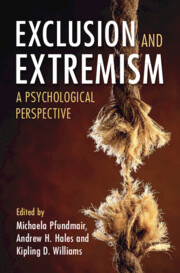Book contents
- Exclusion and Extremism
- Exclusion and Extremism
- Copyright page
- Dedication
- Contents
- Contributors
- Introduction
- Part I The Link between Exclusion and Extremism
- Part II Drivers of the Exclusion–Extremism Link
- Part III Topics Related to the Exclusion–Extremism Link
- 11 Rejection and Serious Aggression
- 12 Chronic Social Exclusion, Radicalization, and Extremism
- 13 Connecting Conspiracy Beliefs and Experiences of Social Exclusion
- Index
- References
11 - Rejection and Serious Aggression
Hurt People Hurt People
from Part III - Topics Related to the Exclusion–Extremism Link
Published online by Cambridge University Press: 16 May 2024
- Exclusion and Extremism
- Exclusion and Extremism
- Copyright page
- Dedication
- Contents
- Contributors
- Introduction
- Part I The Link between Exclusion and Extremism
- Part II Drivers of the Exclusion–Extremism Link
- Part III Topics Related to the Exclusion–Extremism Link
- 11 Rejection and Serious Aggression
- 12 Chronic Social Exclusion, Radicalization, and Extremism
- 13 Connecting Conspiracy Beliefs and Experiences of Social Exclusion
- Index
- References
Summary
When people perceive that they are rejected by others, they may respond in positive ways to regain acceptance or in negative ways to achieve other goals, such as revenge. This chapter examines people’s negative responses to interpersonal rejection. After discussing conceptual issues that have plagued the study of rejection, the chapter examines five forms of extreme aggression in detail: school and mass shootings, intimate partner violence, hazing, retaliative suicide, and cyberbullying. The chapter examines evidence that supports a link between rejection and these five forms of aggression and discusses variables that influence the degree to which people respond aggressively to perceived rejection.
Keywords
- Type
- Chapter
- Information
- Exclusion and ExtremismA Psychological Perspective, pp. 239 - 262Publisher: Cambridge University PressPrint publication year: 2024

